
Spatial audio can make you feel like you are in the centre of the action.
© VLAD KOCHELAEVSKIY OD.ERDE / STOCK.ADOBE.COM
Beautiful noise
Spatial audio takes the concept of surround sound to new heights
by CHRISTINE PERSAUD
You might have heard of spatial audio and wondered what it is. It’s a technology that processes audio to create the illusion that sounds are coming from all around, including from above. You’ll hear it in an action movie with planes flying overhead or cars zooming by in every direction; a romantic comedy with a sappy scene in the pouring rain; a horror flick with scares in every corner; or a musical track with distinctly placed instruments. It can be found in video games, too, like first-person shooters, keeping you apprised of your in-game surroundings.
The term was coined in 2020 by Apple at its developers conference to describe the company’s implementation of immersive audio. But it has since become more generally used to refer to any type of immersive, three-dimensional sound (not unlike how we refer to tissues as Kleenex or bandages as Band-Aids). Spatial audio is cited interchangeably with similar technologies, such as Dolby Atmos, DTS:X, and Sony 360 Reality Audio and 3D Audio. All of these technologies, which come from different companies, accomplish the same thing and fall under the umbrella of “immersive audio.”
The idea with spatial audio, available in products like soundbars, wireless speakers and headphones, is to replicate an immersive audio experience without the use of multiple speakers around you. For a home theatre, spatial audio is a step up from surround sound because you will feel like you’re right in the action. It is available for music, movies, TV shows and video games, though not all titles are mixed for it.
Here’s a look at what you will need to enjoy this technology:
A product that supports it. Products that support immersive audio playback are labeled as such, with words like spatial audio, Dolby Atmos, DTS:X, 360 Reality Audio or another similar term. Spatial audio speakers are made by brands such as Apple and Sonos, 360 Reality Audio headphones from Sony and Atmos soundbars from Samsung. Even some premium smartphones claim to support spatial audio or 3D audio playback.
Content mixed for spatial audio. Video streaming platforms will label the spatial audio content they have available in a similar way. When you go to Netflix, look under the movie or TV show title and you will see a series of icons that may include spatial audio or Dolby Atmos, along with other audio-related features, such as closed captioning. On the Disney+ website scroll to the “Details” tab and look under “Available in the following formats.” This is true for Max, Hulu, Bell’s Crave and others. Not all content is mixed for spatial audio, however. The Witcher on Netflix is available in spatial audio, for example, but Titans is not.
Not all music streaming platforms support spatial audio. Spotify, for example, does not yet support it. However, Apple Music has a dedicated category for spatial audio content. Amazon Music HD, Apple Music and Tidal offer some spatial audio content, too. If you’re unsure of what’s available, type “spatial audio” or “Dolby Atmos” in the general search bar to isolate applicable search results.
An appropriate subscription. Even if the service supports immersive audio, you may need a specific subscription tier to access it. With Netflix, you need the Premium plan. It’s available on music streaming services, too. With Tidal, you need the HiFi Plus subscription tier. Apple Music, however, offers tracks in spatial audio with its base subscription option.
With spatial audio, you can use a single premium speaker (or other audio device) and high quality mixed content to get an impressive, enveloping experience.

JOHN THOMSON
Christine Persaud is a Toronto-based freelance writer. Her work has appeared in Digital Trends, Reviewed/ USA Today, XDA, Android Central and at Wifihifi.com.
All in your head
Spatial audio is handled differently with headphones. A technology called head-related transfer function (HRTF) tricks your brain into believing that sounds are farther away or closer to you than they really are. To enjoy it, use a pair of spatial audio headphones, like the Apple AirPods Max or OnePlus Buds Pro 2 with a compatible smartphone, like the Apple iPhone 14 or OnePlus 11, respectively.—CP
Go big
Even though technology now makes it possible to enjoy immersive audio through a single speaker, for an even better audio experience, the pros will tell you that you need to install multiple speakers in various locations to get the best effect. If you go this route, you’ll want to place speakers at the front and back of the room, at the left and right, the front centre, and above, plus have a subwoofer for enhanced bass. This setup is called a 5.1.2 system: five main speakers plus a subwoofer and two height speakers on the ceiling. A 7.1.2 system adds two more speakers on the sides of the room as well for a movie theatre-like experience.—CP
Costco Connection: You'll find a selection of products that support spatial audio in select Costco warehouses and at Costco.ca.

